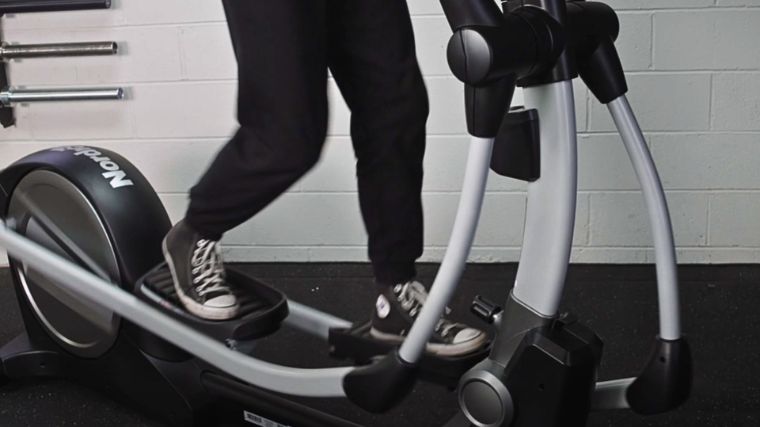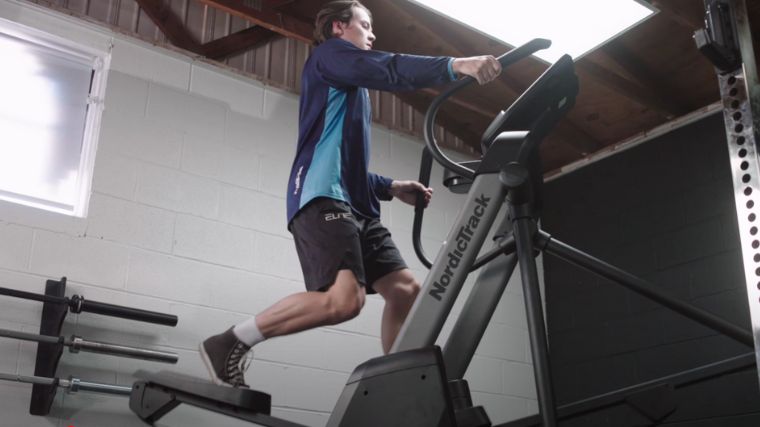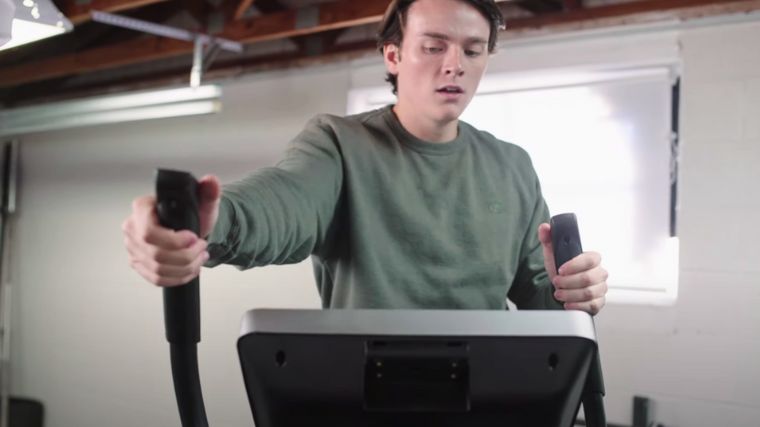Elliptical training is one of the best sources of cardiovascular exercise around. It uses a rhythmic, low-impact motion that jacks up your heart rate while preventing undue soreness from all that banging around on your joints. But elliptical workouts are not all a walk in the park.
The elliptical machine provides resistance levels to suit your every need. This allows your cardio workouts to span from low to moderate-intensity fat-burning workouts to high-intensity interval training (HIIT) and everything in between. Between a set of handlebars, pedals, and continuous leg engagement, be prepared for full-body workouts — these are the muscles worked by the elliptical machine.

Editor’s Note: The content on BarBend is meant to be informative in nature, but it should not be taken as medical advice. When starting a new training regimen and/or diet, it is always a good idea to consult with a trusted medical professional. We are not a medical resource. The opinions and articles on this site are not intended for use as diagnosis, prevention, and/or treatment of health problems. They are not substitutes for consulting a qualified medical professional.
What Muscles Does an Elliptical Work?
The elliptical machine is a unique cardio machine that combines both upper-body and lower-body movement into one total-body workout. There is a wide range of muscle groups working as a result, from your chest, shoulders, arms, legs, back, core, and — of course — the heart. Here are the different muscles on task with this exercise equipment.
Chest
The chest (or pectoralis major) is the big patch of muscle that makes up the upper front part of your torso. It is typically responsible for drawing your arms across your body towards the middle like during a dumbbell bench press or cable fly. This is because it attaches to your upper arm and several different parts of your collarbone, breastbone, and upper ribs. Your chest therefore does part of the pushing part of the handlebar motion during your elliptical workouts.
Shoulders
Most motions that involve the chest similarly draw upon your shoulders to some extent. More specifically, the front of your shoulder (the anterior deltoid) performs nearly identical actions as big parts of your chest.
[Read More: The Best Compact Ellipticals on the Market]
Likewise, during the pushing motion on the elliptical handlebars, the front of your shoulders are worked. Depending on your position, your rear delts might also get some action from pulling the handlebars back toward you.
Arms
The arms are a part of your elliptical motion as well, given that they are attached at all times to the handlebars themselves. The pushing and pulling motions you perform on each stride use different parts of your arms. The push harnesses the triceps to help extend your elbow whereas the pull gets a bit of help from your biceps.
Legs
The legs are one of the most obvious parts of your elliptical workout. The large rhythmic motion on each stride involves nearly all the muscles of your lower body to some extent. Your quadriceps help to extend your knee and push during each rotation whereas your glutes and hamstrings extend your hips and flex your knees to pull the machine back.
Back
Your back is a big contributor to the pulling motion of the handlebars. Each time you draw back, the lats (and to a certain degree the traps and rhomboids) help the biceps complete the motion. While it is a group effort, each of your back muscles gets some love during an elliptical workout.
Core
Although the elliptical machine is a stabilized piece of equipment, your core muscles still get a healthy dose of engagement. The rhythmic nature of elliptical exercise (pulling on one side of the body and pushing on the other) introduces rotation (and anti-rotation) to your torso.

[Read More: The Best Budget Home Gym Equipment]
You’ll balance each rotation with the core engagement you need to produce the force that reverses the course from a push to a pull. It’s your abdominal muscles’ job to help resist and redirect you in the opposite direction.
Heart
Although we’re mostly discussing skeletal muscles here, it’s still worth highlighting the obvious in a cardio workout — your heart. One of the most logical reasons for using elliptical training during your workouts is to improve your cardiovascular performance.
The massive amount of muscles used during each stride directly contributes to blood flow demands, which ultimately draw upon your heart.
Benefits of an Elliptical Workout
Your elliptical workouts are a fantastic way to improve your cardiovascular health and performance. They also contribute significant calories to your energy balance goals, but altogether are relatively low-impact and easy to recover from.
Cardiovascular Health
Cardiovascular health is a goal that impacts all training programs. Whether it’s your top priority or not, your ability to recover between sets and even between training sessions is influenced by your cardiovascular system. The elliptical machine is uniquely equipped to improve your cardiovascular abilities with high efficiency.
[Read More: The Best Cardio Machines on the Market]
The amount of muscle mass that is drawn into a good elliptical workout combined with the low-impact nature of the machine is a one-two punch. The amount of blood flow flying off to each corner of your body, scalable resistance, and low-impact sessions make the elliptical one of the best options for overall cardiovascular health.
Easy Recovery
Certain training variables are more associated with soreness and fatigue than others. For example, eccentric training and novel exercises (things you haven’t done before) are usually highly correlated with delayed onset muscle soreness. (1)
The elliptical is a low-impact style of cardio with a minimal eccentric component and is easy to make a consistent part of your routine. These factors all mean that the elliptical is one of the easier methods of cardio to recover from — and to use as a form of active recovery itself.
Customizable
Since the elliptical provides such a low-impact workout, you’re able to adapt this type of aerobic exercise to meet you wherever you are in your fitness journey. If you want to challenge your leg muscles and generate an intense burn, you can kick up the resistance significantly. But if you want a lower-intensity exercise, you can dial back the resistance and take it slower.
[Read More: The Elliptical Benefits You Need to Know About ASAP]
Muscle-Building Elliptical Tips From a Trainer
The elliptical trainer is a great tool to weave into your workout program. While this machine isn’t primarily used to build muscle, there are a few techniques to harness it as part of a muscle-building routine. From using resistance to changing your direction or arm engagement, you’re able to manipulate the intensity in several ways.
Use Resistance
Applying resistance is one of the key ways to increase muscle-building, heart-thumping stimulus across any form of exercise. Not only does the increased resistance make it harder for you to move on each stride, it increases the likelihood of more muscle fibers being recruited.

[Read More: The Best Ellipticals Under $1,000]
The elliptical trainer is a full-body piece of equipment, but it also has a ton of synergists at play. This means that certain muscles can take the brunt of the effort — that is of course, until the resistance is cranked. With higher resistance levels, more muscle is forced to contribute more effort to complete the task at hand.
Backpedaling
Backpedaling (or reversing the direction of your stride) changes the dynamic of the muscles being worked. Instead of a greater emphasis being placed on the quads during a standard forward motion, backpedaling places more emphasis on your hamstrings to pull on each stride. Whether you’re getting tired and need to swap the burden from one muscle to another or are just interested in a new angle, try tossing in backpedaling.
No Arms
One way to increase the intensity and therefore challenge certain muscles is through addition by subtraction. The full-body nature of the elliptical trainer allows you to increase the difficulty by simply not using some muscles. Taking your arms off of the handlebars redirects their workload to your legs, increasing the amount of stimulus your lower body receives.
Only Arms
While it won’t be technically possible to remove your legs from the elliptical trainer (you still need to be standing after all), you’re still able to reduce the amount of effort you use. Minimize your leg engagement by pumping primarily with your arms.
Some ellipticals may even have a stable foot pedal for you to rest your feet on in a stationary position while working with your arms. Either way, placing more emphasis on your upper body cranks up the effort needed by your back, chest, shoulders, and arms to get the job done.
[Read More: What to Consider Before Buying an Elliptical Machine]
Takeaways
The elliptical machine provides a massive opportunity for gains, here are some key takeaways.
- The elliptical is a full-body exercise machine that excels at cardiovascular training.
- It works a huge variety of muscles including your chest, shoulders, arms, legs, back, core, and heart.
- The elliptical is extremely effective at improving cardiovascular health, has a relatively low impact on your body, and is highly customizable for any experience level.
- You can increase the challenge by using the machine’s resistance, backpedaling, not using your arms at all, or even using your arms exclusively.
Muscle Mayhem
The elliptical trainer is a deceptive little tool sitting in the cardio section of your gym. With both upper and lower body involvement, it sneaks in significant conditioning sessions while harnessing as many muscles as possible.
From your shoulders, chest, arms, legs, back, core, and heart, there’s minimal real estate left unaccounted for. With minimal recovery cost and wild amounts of workout variability, the elliptical trainer is an easy choice for all of your programming needs.
FAQs
The elliptical training is one of the most common machines to find in the gym, here are some frequently asked questions to consider.
Taking 30 minutes on the elliptical machine helps to stimulate a ton of muscles, jacks up your heart rate, and can burn a solid number of calories. From your arms to your legs and everything in between, the elliptical trainer keeps a massive amount of muscle involved. You get a great dose of cardiovascular and energy balance benefits from using the elliptical machine for even just a half hour.
The two major differences between the elliptical and a treadmill are that the elliptical is a low-impact alternative (no repeated strikes against the ground) and that it also heavily involves the upper body. Both are fantastic tools for cardiovascular training and easy to weave into a program, but the elliptical trainer is a little more recovery-friendly.
One study suggests that people can burn around 180 calories per hour on the elliptical. (2) However, the amount of calories burned by elliptical training varies heavily based on your body size, duration of your session, and resistance applied. Although each machine typically has a calorie expenditure tracker, be cautious with using them as they are often (at least slightly) inaccurate.
Regardless of accuracy, if you are consistent with your sessions you’ll be able to better predict the impact on your energy balance due to regularly completing the same effort.
References
- Hotfiel, T., Freiwald, J., Hoppe, M. W., Lutter, C., Forst, R., Grim, C., Bloch, W., Hüttel, M., & Heiss, R. (2018). Advances in Delayed-Onset Muscle Soreness (DOMS): Part I: Pathogenesis and Diagnostics. Delayed Onset Muscle Soreness – Teil I: Pathogenese und Diagnostik. Sportverletzung Sportschaden : Organ der Gesellschaft fur Orthopadisch-Traumatologische Sportmedizin, 32(4), 243–250.
- Rovniak LS, Denlinger L, Duveneck E, Sciamanna CN, Kong L, Freivalds A, Ray CA. Feasibility of using a compact elliptical device to increase energy expenditure during sedentary activities. J Sci Med Sport. 2014 Jul;17(4):376-80.
The post What Muscles Does An Elliptical Work? Plus Muscle-Building Elliptical Tips from a Personal Trainer appeared first on BarBend.

